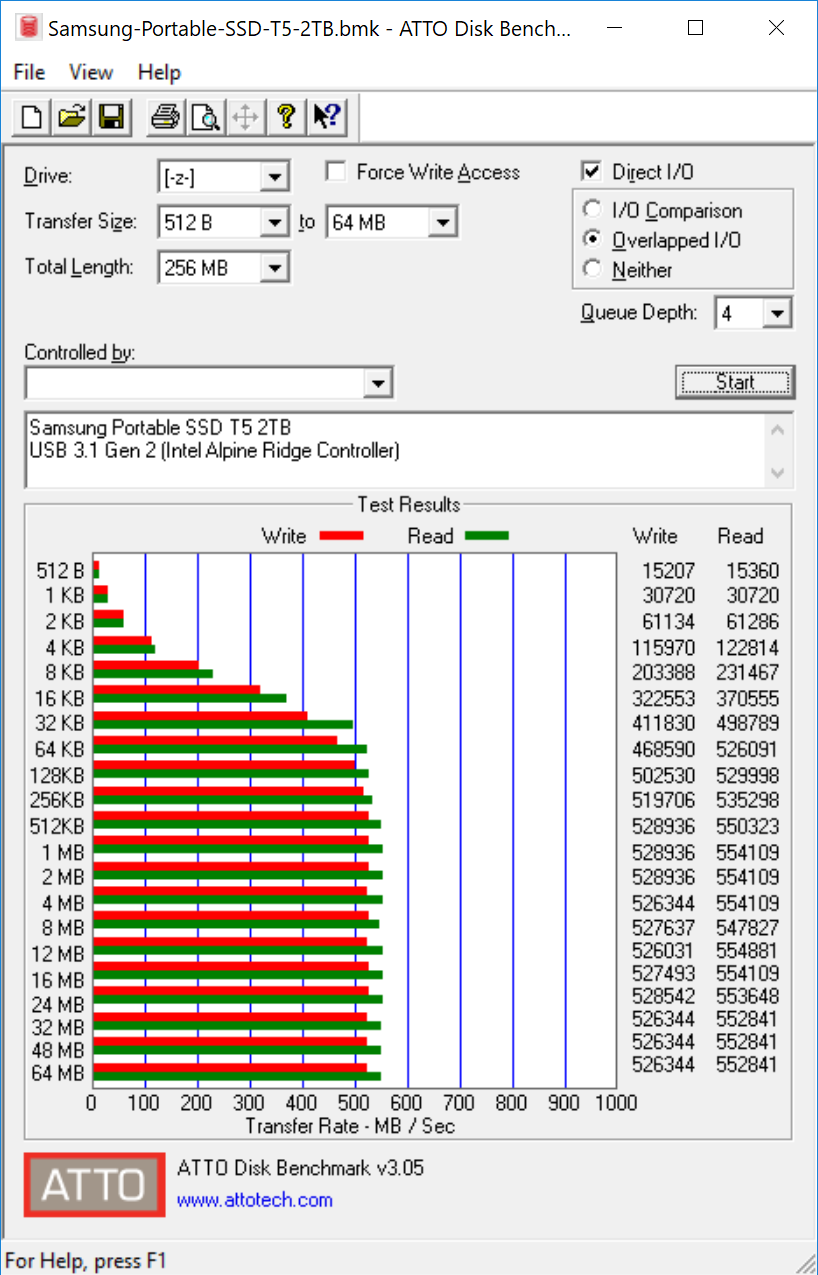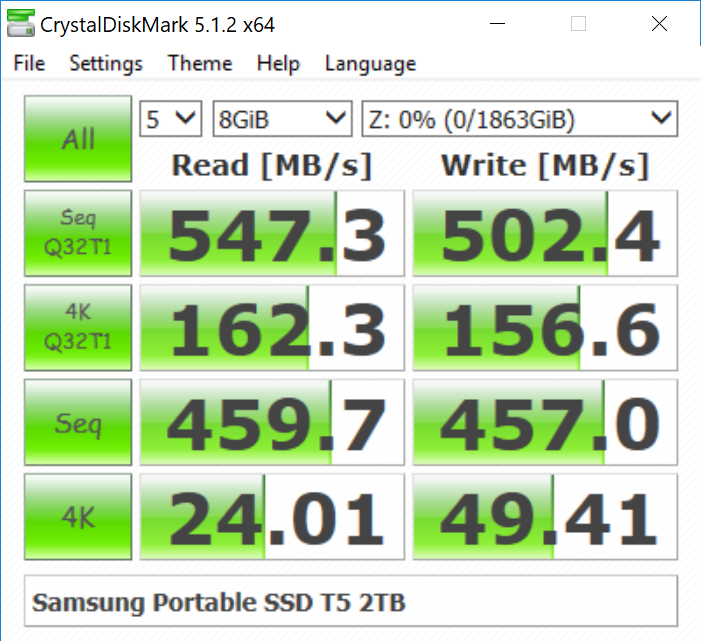Samsung Portable SSD T5 Review: 64-Layer V-NAND Debuts in Retail
by Ganesh T S on August 15, 2017 10:00 AM ESTSynthetic Benchmarks
Various synthetic benchmarks are available to quickly evaluate the performance of direct-attached storage devices. Real-world performance testing often has to be a customized test. We present both varieties in this review, starting with the synthetic benchmarks in this section. Prior to covering those, we have a quick look at our testbed setup and testing methodology.
Testbed Setup and Testing Methodology
Evaluation of DAS units on Windows is done with the testbed outlined in the table below. For devices with a USB 3.1 Gen 2 (via a Type-C interface) connections (such as the Samsung Portable SSD T5 that we are considering today), we utilize the USB 3.1 Type-C port enabled by the Intel Alpine Ridge controller. It connects to the Z170 PCH via a PCIe 3.0 x4 link.
| AnandTech DAS Testbed Configuration | |
| Motherboard | GIGABYTE Z170X-UD5 TH ATX |
| CPU | Intel Core i5-6600K |
| Memory | G.Skill Ripjaws 4 F4-2133C15-8GRR 32 GB ( 4x 8GB) DDR4-2133 @ 15-15-15-35 |
| OS Drive | Samsung SM951 MZVPV256 NVMe 256 GB |
| SATA Devices | Corsair Neutron XT SSD 480 GB Intel SSD 730 Series 480 GB |
| Add-on Card | None |
| Chassis | Cooler Master HAF XB EVO |
| PSU | Cooler Master V750 750 W |
| OS | Windows 10 Pro x64 |
| Thanks to Cooler Master, GIGABYTE, G.Skill and Intel for the build components | |
The full details of the reasoning behind choosing the above build components can be found here. The list of DAS units used for comparison purposes is provided below.
- Samsung Portable SSD T5 2TB
- Samsung Portable SSD T5 500GB
- ADATA SD700 512GB
- Corsair Voyager GS 512GB
- G-DRIVE slim SSD USB-C 500GB
- Samsung Portable SSD T3 2TB
- SanDisk Extreme 900 1.92TB
ATTO and Crystal DiskMark
Samsung claims speeds of up to 540 MBps, and it is backed up by the ATTO benchmarks provided below. Unfortunately, these access traces are not very common in real-life scenarios.

CrystalDiskMark, despite being a canned benchmark, provides a better estimate of the performance range with a selected set of numbers. As evident from the screenshot below, the performance can dip to as low as 24 MBps for 4K random read accesses. The 3x - 6x increase in performance at higher queue depths for these random accesses shows that UASP is active and working well.











38 Comments
View All Comments
timecop1818 - Tuesday, August 15, 2017 - link
what workload on a Macintosh would require so much data transfer anyway? you don't need 3000mb/sec to stare at a desktop or play candy crushjdshewman - Wednesday, August 16, 2017 - link
Photographers, HD and 4K video. With the abundance of travel bloggers and drones, extra storage with speed is valuable.AnTech - Thursday, August 17, 2017 - link
Which one? Any of these or is there anyone else coming?Sonnet Fusion Thunderbolt 3 PCIe Flash Drive
http://www.sonnettech.com/product/fusiontb3pciefla...
JMR Lightning LTNG-XTD portable Thunderbolt SSD
http://jmr.com/product/jmr-lightningltng-xtd-porta...
name99 - Wednesday, August 16, 2017 - link
Of course it is. Macs have handled booting from external drives since forever (at least the initial FireWire days). I run my iMac 2012 off an external USB3 SSD because the internal HD failed. Hell, you can even create a fusion boot drive between an external SSD and an internal hard drive if you like, and that's how I run my 2007 iMac (SSD connected via FW800).Being able to boot painlessly from external drives is one of the great Mac advantages that Win and Linux folks don't seem to know about because it's not part of their world. I do it all the time, sometimes for machines whose internal drives die, sometimes to give a speed boost to an old machine (like the 2007 iMac setup I described above), sometimes as a diagnostic when a machine seems to be behaving badly. (Good way to learn/test that an internal HD is going bad...)
Obviously you will want to format the external drive to JHFS+ (or wait two months and format it to APFS...), you can't boot off exFAT or NTFS or whatever it comes formatted with.
VulkanMan - Tuesday, August 15, 2017 - link
How long can these retain the data without being powered?Is that information included anywhere?
coder543 - Tuesday, August 15, 2017 - link
No one lists that information for any SSD that I've seen, but the minimum JEDEC spec for a consumer SSD is one year without power. Realistically, I have trouble imagining less than 5 years being a problem, but it would be interesting to have numbers.VulkanMan - Tuesday, August 15, 2017 - link
Most SSDs have been internal and those usually get powered up daily / weekly.Since these are external, not everyone is going to know that they must power the devices up at least once every X months, so they shouldn't be used for long term storage.
I would think they would put warnings on these that data loss is possible if you don't power them up semi-frequently.
Billy Tallis - Tuesday, August 15, 2017 - link
Powering up the drive periodically or even continuously doesn't solve anything. All of the data has to be moved or re-written in order to prolong retention times. But since those retention times are measured in years not months, it's not worth warning about.Billy Tallis - Tuesday, August 15, 2017 - link
JEDEC spec is for one year of unpowered data retention after the drive's rated write endurance has been exhausted. A drive that hasn't been absolutely hammered with writes will retain data far longer.Bullwinkle J Moose - Tuesday, August 15, 2017 - link
I'll stick with an 850 Pro because it works on any USB 3 and 3.1 port with an adapterThe 850 Pro is faster than this drive as well
I avoid "USB Only" external drives because you can only install Windows 2 Go Spyware Platforms on them
With the 850 Pro, I can also install Windows XP and use it with SATA and ESATA ports as well as any USB port
With this one, you are stuck with USB only
So sad!